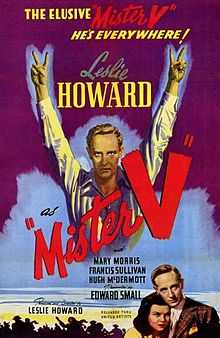"Pimpernel" Smith
| "Pimpernel" Smith | |
|---|---|
 US Film Poster | |
| Directed by | Leslie Howard |
| Produced by |
Leslie Howard Harold Huth (assoc.) |
| Written by |
Baroness Orczy (novel) Anatole de Grunwald |
| Starring |
Leslie Howard Francis L. Sullivan Mary Morris |
| Studio | British National Films |
| Distributed by | Anglo-American Film Corporation |
| Release dates |
|
| Running time | 120 minutes |
| Country | United Kingdom |
| Language | English |
"Pimpernel" Smith (released in the United States as Mister V) is a British 1941 anti-Nazi thriller,[1] produced and directed by its star Leslie Howard, which updates his role in the 1934 The Scarlet Pimpernel from Revolutionary France to pre-World War II Europe. The British Film Yearbook for 1945 described his work as "one of the most valuable facets of British propaganda".[2] The film is also notable for helping to inspire Swedish diplomat Raoul Wallenberg to mount his real-life rescue operation in Budapest that saved tens of thousands of Hungarian Jews from Nazi concentration camps during the last months of World War II.[3]
Plot
Eccentric Cambridge archaeologist Horatio Smith (Howard) takes a group of British and American archaeology students to pre-war Nazi Germany to help in his excavations. His research is supported by the Nazis, since he professes to be looking for evidence of the Aryan origins of German civilisation. However, he has a secret agenda: to free inmates of the concentration camps. During one such daring rescue, he hides disguised as a scarecrow in a field and is inadvertently shot by a German soldier idly engaging in a bit of target practice. Wounded, he still manages to free a famous pianist from a work gang. Later, his students guess his secret when they see his injury and connect it to a story about the latter-day Scarlet Pimpernel in a newspaper. They enthusiastically volunteer to assist him.
German General von Graum (Sullivan) is assigned to find out the identity of the "pimpernel" and eliminate him. Von Graum forces Ludmilla Koslowski (Morris) to help him by threatening the life of her father, a Polish democrat, held prisoner by the Nazis. When Smith finds out, he promises her he will free Koslowski.
Smith and his students, masquerading as American journalists, visit the camp in which Koslowski is being held. They overpower their escort, put on their uniforms, and leave with Koslowski and some other inmates. By now, von Graum is sure Smith is the man he is after, so he stops the train transporting the professor and various packing crates out of the country. However, when he has the crates opened, he is disappointed to find only artefacts inside.
Von Graum still has Ludmilla, so Smith comes back for her. The general catches the couple at a border crossing. In return for Ludmilla's freedom, Smith agrees to give himself up. Smith tells Graum that the artefacts he has discovered disprove Nazi claims about the Aryan origins of the Germans. He predicts the Nazis will destroy themselves. In the end, Smith manages to distract his adversary and escape into the fog, but promises to come back.
Cast
- Leslie Howard as Professor Horatio Smith
- Francis L. Sullivan as General von Graum
- Mary Morris as Ludmilla Koslowski
- Hugh McDermott as David Maxwell
- Raymond Huntley as Marx
- Manning Whiley as Bertie Gregson
- Peter Gawthorne as Sidimir Koslowski
- Allan Jeayes as Dr. Beckendorf
- Dennis Arundell as Hoffman
- Joan Kemp-Welch as Teacher
- Philip Friend as Spencer
- Laurence Kitchin as Clarence Elstead
- David Tomlinson as Steve
- Basil Appleby as Jock MacIntyre
- Percy Walsh as Dvorak
- Roland Pertwee as Sir George Smith
- A.E. Matthews as Earl of Meadowbrook
- Aubrey Mallalieu as Dean
- Ben Williams as Graubitz
Inspiration for Raul Wallenberg
When Pimpernel Smith reached Sweden in November 1943, the Swedish Film Censorship Board decided to ban it from public viewing,[4] as it was feared that such a critical portrayal of Nazi Germany could harm Sweden's relationship with Germany and thus jeopardise the country's neutrality in World War II. Raul Wallenberg did, however, manage to see it at a private screening together with his half sister, Nina Lagergren, and she recalled that on their way home after the screening, "he told me this was the kind of thing he would like to do."[5] Wallenberg had made frequent trips to Hungary since 1941, as representative and later joint owner of an export-import company that was trading with central Europe and was owned by a Hungarian Jew, and knew how oppressed the Hungarian Jews were.
In August 1944, Wallenberg was sent to Budapest as First Secretary to the Swedish legation, assigned under secret agreement between the US and Swedish governments to organise a rescue programme for the Jews, following the mass deportations that had started in April 1944. By issuing "protective passports", which identified the bearer as Swedish, and housing them in 32 buildings that he rented and declared Swedish territory, he managed to rescue tens of thousands from the German death camps.
In May 1945, the film was released in Sweden without any age restrictions.[4]
See also
References
- ↑ The Monthly Film Bulletin, Volume 8, No.91, July 1941
- ↑ Peter Noble (ed.), British Film Yearbook for 1945, London, 1945, p. 74.
- ↑ Linnéa, Sharon, Raoul Wallenberg: The Man Who Stopped Death, Jewish Publication Society of America, copyright 1993.
- ↑ 4.0 4.1 Svensk Filmdatabas, Pimpernel Smith
- ↑ Furlong, Ray. "Wallenberg family mark centenary with plea for truth". BBC News. 8 August 2012. Accessed 31 January 2012.
External links
- 'Pimpernel' Smith (1941) at screenonline.org.uk
- Pimpernel Smith stills from BlakeneyManor.com
- Pimpernel Smith at the Internet Movie Database
| ||||||||||||||||